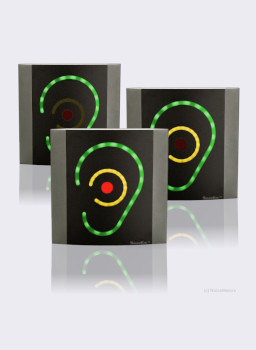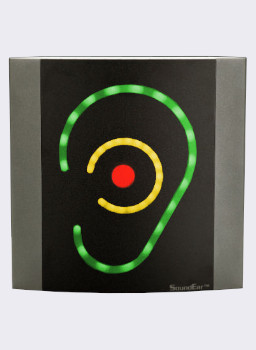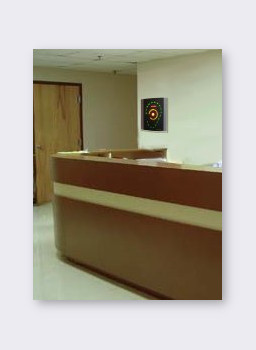




The delivery price is calculated during checkout based on your location and the goods ordered. Our basic delivery prices are:
Delivery within USA: $40.00
Delivery Service: Five working days*
* For products that are in stock and the order received by midday.
Some products go through a final configuration and calibration before being shipped. If the calibration labs are busy this can add up to two days on to the delivery schedule but guarantees a fresh calibration.
The SoundEar Noise Activated Sign presents a clear and unmistakable warning as soon as the noise exceeds the preset limit. Children and adults can easily understand the warning symbol so that immediate action can be taken. It mounts on the wall and plugs into an outlet with the adapter that is included.
This sign was designed in Scandinavia to look at home on the wall of any office, school classroom or factory.
The noise limit is selectable to suit the function of the room. It can be set in 5 dB steps to a level between 40 and 115 dB(A) using the control on the back. These settings represent the noise levels between a classroom and a rock concert.
The yellow lights come on just before the limit is reached. As soon as the limit is exceeded the red part lights up and the word WARNING is displayed.


The SoundEar Classic hangs on a single screw, like a picture, and so is very quick and easy to install. The power adapter is included.
The Noise Warning Sign has proved very popular for use on hospital units, reminding people to be quiet in the usual locations:
These signs are commonly used within NICU and neonatal units, as well as on other general and intensive care units to remind not just the visitors but also the staff and patients to keep their noise levels down.
The mere existence of the noise warning sign in an obvious location is often enough to remind people about the area's sensitivity to noise.
Other than important alarms, there is usually no need for excessive noise on a hospital unit. It is usually caused by visitors and sometimes staff talking louder than necessary or people being careless when moving medical equipment or patients between rooms.
The SoundEar is a clear and simple reminder to keep the noise levels down and if you forget it lights up to remind you.
The perfect location for a sign depends on the layout and the acoustics of the area in question. The most important aspect of the SoundEar is that it reminds people to keep the level down, so it is best to mount them where they are clearly visible to anybody entering the room or area. Often the Nurses Station is a good place to position one unit as this is usually in view to any body visiting and also to constantly remind the staff.

There is no simple rule about the level at which the sign should light up. Hospital rooms and areas have different ambient noise levels and different acceptable limits. An intensive care unit will have a much lower noise threshold than a busy area dealing with less critical illnesses. The best way to find the comfortable limit for an area it to set the sign up to 55 dB (using the dial on the back). Run the sign for a few hours, or even a few days, and get a feel for whether it is being too sensitive for the given environment or whether it is letting people get away with too much. Adjust up or down by 5 dB as needed.
A level of 45 to 55 dB is common for neonatal and intensive care areas and 50 to 60 dB is common for other areas, although it does depend a lot on the acoustics of the areas in question.
Hospitals with concern about the noise levels in neonatal, intensive care and children's units are our biggest customers for the noise warning sign. Babies in intensive care are particularly sensitive to high noise levels and to the increased stress that they cause.
Noise from visitors and staff is best dealt with using a device such as the SoundEar as it is not influenced by the complicated human perception of noise.
Neonatal units, like most hospital environments, tend to be very poor acoustically due to hard, reflective surfaces. Beds are often closely spaced, visitors can talk loudly (especially the younger ones) and staff have to work quickly and move equipment about. Add to this the incubators being opened and closed, occasional tapping on the lid and items dropped accidentally and the noise levels soon become unpleasant for the baby. One of the biggest culprits is the alarm, which is clearly essential, but as the background noise levels get higher the alarm has to be louder still. A quieter background allows for quieter alarms.
The immediate effects of noise in the neonatal unit are reasonably clear. The baby's sleep is easily disturbed and sudden loud noises (bangs on the incubator for example) can have a startling affect on the heart rate and breathing patterns.
High and intermittent noise is also unpleasant and distracting for both staff and parents. Defined "Quiet Times", when noise and light levels are kept down, certainly help and are now used in many units.
The long term effects of noise in the NICU are not so obvious. Hearing impairment as a result of exposure to high noise levels can be expected but research over the last few years has also shown a link with language development. This seems to be related to the fact that a baby that goes full term is only exposed to lower frequency noise (< 250 Hz) during the brain and sensory development stages.
The SoundEar Noise Warning Sign can be the ideal tool to deal with certain noise problems in the workplace. After carrying out a survey using a suitable sound level meter, the Noise Warning Sign can be used to inform staff and visitors how and when to act.
A noise sign is not an alternative to carrying out a full noise survey using a suitable sound level meter, but is very useful to let employees know when it is time to take action - reduce the noise or wear protection.
For information about assessing and controlling workplace noise, please visit our Noise at Work page.
When you have industrial processes that are not constant, the result is intermittent noise and a situation where hearing protection is only needed at certain times. The Noise Warning Sign can be used to automatically let people know when they should wear their hearing protectors and when the noise levels are acceptable.
The signs should be mounted on the wall and the level set so that the yellow and red lights indicate high noise levels at the point where people are working - not just the point where the sign is mounted. In large areas a number of signs will be needed to cover the different noise levels that will exist.
Offices can suffer from high noise levels, particularly when staff are using telephones in open plan areas. High noise levels in call centers makes it difficult for staff to work and does not give a good impression to whoever is at the other end of the telephone call. A noise warning sign can be used to remind staff to keep their voices down in consideration of others.
Controlling such office noise can be difficult because of different peoples perception of what is too noisy. A persons hearing is also dulled during the day so something that seems a little loud in the morning can seem better during the afternoon. Using a noise warning sign to indicate when the levels are high takes away this perception problem.
We have a number of other solutions for monitoring and controlling office noise, including:
Music from pubs, clubs, discos and even restaurants and hotels can cause problems for local residents and be at dangerous levels for staff. The SoundEar Noise Warning Sign is the perfect solution to keeping control of the noise and monitoring the effectiveness of controls.
The SoundEar Noise Warning Sign can be set to light first the yellow and then the red lights when the noise level is above the set limit.

One of the major problems of controlling noise levels in clubs is that of human perception. If the music is to somebody's taste it will not sound so annoying as to whom it is not. On top of this, after just a short time being exposed to high levels the ear becomes less sensitive so it is very difficult to decide whether the level is too high without the use of a noise level measuring device such as the SoundEar.
The SoundEar is mounted on the wall using a single screw and plugs into the power using the adapter provided. It is very quick and easy to install.
| Red Light Limit | 40 - 115 dB(A) |
| Yellow Lights | 5 dB before limit |
| Power Supply | 110 V or 240 V AC (adapter included) |
| Power Consumption | approx. 3W |
| Dimensions | 280 x 280 x 60 mm 11" x 11" x 2.3" |
| Weight | 1.5 kg, 53 ounces |